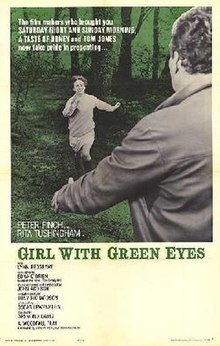Girl with Green Eyes
| Girl with Green Eyes | |
|---|---|
 Theatrical release poster | |
| Directed by | Desmond Davis |
| Written by | Edna O'Brien |
| Produced by | Oscar Lewenstein |
| Starring | Peter Finch Rita Tushingham Lynn Redgrave Marie Kean Arthur O'Sullivan Julian Glover |
| Cinematography | Manny Wynn |
| Edited by | Brian Smedley-Aston |
| Music by | John Addison |
Production company | |
| Distributed by | United Artists |
Release date |
|
Running time | 91 minutes |
| Country | United Kingdom |
| Language | English |
| Budget | £140,000[1] |
Girl with Green Eyes is a 1964 British
The film studies the blossoming relationship between a young girl and a man twice her age.
Plot
Kate Brady, a young girl just out of
Kate is attracted to him, and when she happens to see him again in a Dublin bookshop, uncharacteristically approaches him and strikes up a conversation. A friendship, and later a romantic relationship, develops between Kate and Eugene despite their age difference. Although clearly in love, and happy to join him in bed, she is unable to have sex. The repeated inability to have sex with Eugene starts to take its toll. The relationship worsens on her discovery that he is married with a child, although separated from his wife who has gone to the United States to obtain a divorce.
When Kate's father learns that his daughter is seeing a married man and thus apparently committing adultery, he and his friends go to Dublin and force Kate to return to his rural home. She sneaks out on the first morning but is waylaid by a cowhand. Later when the priest begins to lecture her she runs off. She returns to Eugene. Kate's father and his friends appear unexpectedly and punch Eugene in the face, but are driven off by his no-nonsense housekeeper Josie, who fires a shotgun at the ceiling and threatens them with the second barrel, forcing them to leave. Kate and Eugene then finally succeed in consummating their relationship.
He buys her a ring and Kate treats it as a wedding ring. She starts wearing make-up and wearing her hair up, looking much more sophisticated. She tells a stranger "I got married today". They live together for a time.
Eventually, Kate becomes unhappy as Eugene does not share her
Kate leaves Eugene and returns to Baba, who is packing to move to London. She invites Kate to come along with her. Kate hopes that Eugene will come after her and she looks expectantly at the people on the dock edge as they sail off. He does not appear. Instead he sends word through Baba that their break-up is probably for the best. He wishes he had been younger or she had been more mature. Kate narrates explaining that she has changed and that she goes to night school. She meets "different people, different men".
Cast
- Rita Tushingham as Kate Brady
- Lynn Redgrave as Baba Brennan
- Peter Finch as Eugene Gaillard
- Marie Kean as Josie Hannigan
- Arthur O'Sullivan as James Brady
- Julian Glover as Malachi Sullivan
- T. P. McKenna as Father Brown the priest
- Lislott Goettinger as Joanna
- Pat Laffan as Bertie Counihan
- Eileen Crowe as Mrs. Byrne
- May Craig as Aunt
- Joe Lynch as Andy Devlin
- Yolande Turner as Mary Maguire
- Harry Brogan as Jack Holland
- Michael Hennessey as Davey
- Joe O'Donnell as Patrick Devlin
- Micheal O'Briain as Lodger
- David Kelly as Ticket Collector
Critical reception
In The New York Times, Bosley Crowther wrote "Girl with Green Eyes is another of those remarkably fresh and natural films that have come from the Woodfall organisation, which is sparked by protean Tony Richardson and which has given us such a dazzling range of pictures as A Taste of Honey, Loneliness of the Long Distance Runner and Tom Jones. While it is not as ambitious or extensive as any of those, it is a wonderfully tender, touching and humorous little drama of a lonely Irish girl."[2] Similarly, Variety wrote that the film "has the smell of success," and that director "Davis is imaginative, prepared to take chances and has the sympathy to draw perceptive performances from his cast."[3]
References
- ^ Alexander Walker, Hollywood, England, Stein and Day, 1974 p261
- ^ "Screen: 'Girl With Green Eyes' Arrives". The New York Times. 11 August 1964.
- ^ "Girl with Green Eyes". Variety. 1 January 1964.
External links
- Girl with Green Eyes at IMDb
- Girl with Green Eyes at AllMovie
- Girl with Green Eyes at the TCM Movie Database
